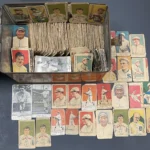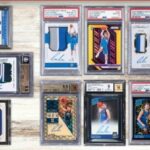When 2020 rolled around, the sports card market, inactive for years, blossomed into a serious investment opportunity. Many new collectors have entered the market as a result, as have seasoned collectors who last participated in the hobby as children and are now doing so again after decades. Before reading the article, you can check out this Amazing App, ESPN Fantasy Sports, that comes with your favorite experts and customizable rankings.
History of sports cards
Though there’s been renewed interest in sports cards over the past several years, cards have a long and rich history that spans more than 150 years. These collectibles originated in the 19th century when cigarette and candy businesses started bundling baseball cards with their products to promote sales by capitalizing on the sport’s popularity. Despite the common perception that there are only two periods for sports cards (vintage and modern), there are five distinct periods, each with specific qualities. The cutoff dates are not perfect, but while looking at a single card, it is vital to grasp the approximate timeframe it comes from.
Pre-World War II vintage (before 1941)
Baseball cards predominate because baseball was the most popular sport in the United States before World War II. The American Tobacco Company, for example, released the renowned T206 series in 1909, but the cards were more typically used as packaging for cigarettes and chewing gum than collectors. As a result, many of them are in terrible shape. There weren’t many cards overall, though, because whole sets weren’t being printed annually until the early 1930s. Since cards from the turn of the century are hard to come by in general and in good condition, even more so, low-grade issues can command a high price. Many cards from the famous 1933 Goudey set are still in good shape nearly ninety years after their first release, demonstrating a period of intense production in the early 1930s. Compared to just 4.0% of 1909-11 T206s, 12.4% of 1933 Goudeys are graded as PSA 7s or higher.
Post-World War II vintage (1945-1979)
Sports cards entered a golden age in the 1950s, thanks to the efforts of companies like Leaf Candy, Bowman Gum, and Topps Gum, all of which entered the market after World War II. By the mid-1950s, Topps had established itself as the industry standard, and its baseball cards have become icons of the era. Our elders quickly remind us that this is when the Baby Boomer generation first began collecting trading cards. Their fond memories of this era fuel much of the luxury industry today. Even though trading cards for other sports (such as the first official basketball set produced by Bowman in 1948) began to appear during this period, most of the most famous cards from this era are baseball cards. There is a shortage of mint condition cards since no one ever put any stock in maintaining them or thought they might be valuable in the future. There are several anecdotes about children who foolishly put sound trading cards between their bicycles’ spokes or whose parents carefully disposed of their collections.
Junk Wax Era (1980-1996)
In the 1980s, when Boomers finally had discretionary income, the value of some cards they had when they were kids skyrocketed, sparking massive expansion. The market was flooded with products from new businesses like Fleer, Donruss, Score, and Upper Deck to keep up with surging demand. Moreover, card collectors were better educated on maintaining mint condition and safely storing their collections. Due to this fact, only the most mint examples of cards from this era are worth anything. Too many were made, and many more are still around in pristine shape. Many baby boomers keep their junk wax collections in a closet or at their parent’s house, hoping they will increase in value someday.
Modern Era (1997-2012)
Numerous members of Generation X and Millennials abandoned sports card collecting as a result of the trash-wax era. Our “Trading Card Winter” has officially begun. From 1997 on, companies started releasing limited-edition “insert” cards, which often featured autographs and game-used items and became highly sought after. Inserts offer artificial scarcity due to their limited print runs, while antique cards have a natural shortage due to the lack of cards from those eras remaining in acceptable condition. As a result, some of the rarest cards in the set are now among the most valuable in the whole sports card market. During this time, with the rise of the NBA and the fall of baseball’s appeal, basketball cards eclipsed baseball cards in popularity.
Parallels Era (2013-Present)
That’s how we got to the point where limited print runs, autographs, and patch cards are the only cards worth collecting nowadays, and entire sets and boxes are made up of them. For instance, a 2020-21 Panini National Treasures Basketball Cards package contains ten individual cards and sells for at least $5,000. Four autograph cards, four memorabilia cards, one printing plate card, and one regular or parallel regular card are included in each box. As a result of the proliferation of parallels, subsets, and subtle changes in card design, it can be challenging to determine which rookie cards are best for a given player. Justin Herbert has so many starting quarterbacks on the rise, and there’s a list of the top 70. Even though one-of-a-kind cards and highly sought-after rookie patch signature cards can still fetch sky-high prices, others have lamented that we have entered a new era of junk wax, wherein the proliferation of so-called “unique” cards has rendered even the most valuable of them worthless. Furthermore, because the players from this era are still active and playing, there is a great deal of price fluctuation based on current player and team performance, making cards from this era undoubtedly the most speculative.
NFTs (Non-Fungible Tokens)
Non-fungible tokens (NFTs) can be used to prove ownership of nearly anything in the digital realm, from works of art to virtual real estate. In the past, it was risky and difficult to verify ownership of digital assets, but with the advent of NFTs, this process is now far more secure and straightforward.
Depending on who you ask, the phrase “CryptoArt” can evoke many feelings. The blockchain, decentralization, verifiable scarcity and authenticity, and most importantly, artist advocacy are all
On January 19, 2019, our colleagues at Artnome published a fantastic piece that does a great job of explaining what CryptoArt is—brought together in CryptoArt and NFTs. If you want a more comprehensive breakdown, be sure to read it. However, for the benefit of those whose time is restricted, we shall concisely summarize the context.
Non-Fungible Tokens (NFTs) are denoted since they are not interchangeable with other NFTs or fiat currencies like bitcoin or dollars.
History of NFTs
CryptoPunks, Rare Pepe, and CryptoKitties were the cultural phenomena that inspired the CryptoArt subgenre. Because of the viral network effects and the high demand, these works of “art” became widely known and sought after.
Let’s jump in because this is a lengthy tale involving a wide range of participants, creative endeavors, and periods.
2012-2013: Colored Coins
The concept of NFTs was born in 2012–2013 with the introduction of a “colored currency” on the Bitcoin network. The initial idea was to use the Bitcoin blockchain for digital assets such as collectibles, coupons, property, company shares, etc. Tokens with different colors symbolize different types of support on the blockchain, from gold and silver to vehicles and real estate to stocks and bonds. They were called cutting-edge technology that offered enormous potential for future applications.
2014: Counterparty
Counterparty is a decentralized, open-source internet protocol and peer-to-peer financial platform created in 2014 by Robert Dermody, Adam Krellenstein, and Evan Wagner. It is based on the Bitcoin blockchain. Counterparty lets users build their currency that could be traded with others as a decentralized exchange supporting asset creation. In addition to other concepts and possibilities, it allowed for the trade of memes without the risk of counterfeiting.
2015: Spells of Genesis on Counterparty
Counterparty joined forces with the developers of Spells of Genesis in April 2015. The Spells of Genesis game developers were not just early adopters of putting in-game assets onto a blockchain via Counterparty but also early adopters of launching an initial coin offering. Counterparty’s designers introduced a virtual currency called BitCrystals to help finance the project.
2016: Trading Cards on Counterparty
New tendencies showed up in August of 2016. Force of Will is a popular trading card game, and Counterparty has partnered with them to release their cards on the Counterparty platform. From a sales perspective, Force of Will ranked fourth in North America, after Pokemon, Yu-Gi-Oh, and Magic. Even if they were unfamiliar with blockchain technology or cryptocurrencies, the fact that they decided to join the ecosystem proved their worth.
2017: Cryptopunks
John Watkinson and Matt Hall, the founders of Larva Labs, noticed a rise in demand for Rare Pepes, so they randomly developed a system to produce characters on the Ethereum blockchain. There would be a cap of 10,000 characters, and no two would be alike. Named after a 1990s Bitcoin experiment, the Cryptopunks project is a cross between an ERC721 token and an ERC20 token.
2018-2021: The NFT Explosion
The mainstream adoption of NFTs is expected to explode in the early 2020s after a gradual increase in public awareness from 2018 to 2020.
The crypto community’s supposedly subterranean activity is gradually becoming more popular. The artist, Kevin Abosch’s collaboration with GIFTO for Valentine’s Day 2018 charity auction marked a turning point in this evolution. Because of their cooperation, a stunning piece of CryptoArt titled “The Forever Rose” sold for $1 million.
Mr. Abosch upped the ante further by combining his blood with the Ethereum blockchain in a venture dubbed “IAMA Coin.” Others in the art world have joined Abosch in exploring these novel methods of expression. Artists eager to experiment with new forms have helped it gain traction.
The NFT market is more streamlined and liquid than traditional asset transfer techniques. Many internet venues have emerged, providing unique features that artists and collectors appreciate. Traditional art brokers, such as auction houses, take a hefty cut (often as high as 40 percent) of the sale price of an artwork. If you’re looking to buy or sell artwork, music, domain names, collectibles, or trading cards, look no further than Opensea. The main goal of the Mintable platform is to simplify the minting procedure for the creators. Portion aspires to provide a platform for NFTs, DeFi, and DAOs where the community, represented by the governance token $PRT holders, makes all of the decisions. Like Niftex, other platforms let users purchase “shards,” ERC20 tokens representing a portion of a full NFT.
The Rise of Sorare Using NFTs
Kylian Mbappé has joined the soccer video game built on Ethereum NFTs as a financial backer and spokesperson. Sorare’s secondary market sales have risen by over 700% since then. This resulted from including the French soccer star in their NFTs game.
Sorare NFT markets have seen dramatic growth in secondary market trading, according to data. A rise of 795% from the previous day’s NFT sales volume was announced by Sorare, bringing the total for the past 24 hours to over $6.6 million.
That’s over $3.2 million more than second-place CryptoPunks, and more than twice as much as any other project that CryptoSlam tracks. Sorare’s weekly total of $10.1 million is second only to the Bored Ape Yacht Club’s roughly $12 million over the same period.
The Rise of Fanzone Sports Club Using NFTs
Many of the most recent NFT endeavors are designed to be members-only affairs. The owner of a given NFT can thus participate in the NFT project as part of a larger community.
Owners of these NFTs can get together for things like VIP get-togethers, parties, and events or to have candid conversations about the project’s future with the team behind it. This kind of closed-door community boosts the value of NFT projects.
Football fans worldwide can take advantage of that at Fanzone Sports Club (soccer). Instead of NFT artwork, fans are given NFT passes at the team’s off-field events. In the same vein as a football season ticket, but with more benefits.
There are three kinds of passes: gold, black, and diamond. If the team plans to drop any NFTs, holders of any of the three passes will get early access to buy them, as well as additional perks like 10% referral bonuses, exclusive meets, and the chance to meet football heroes and other famous athletes on stadium tours.
The diamond pass offers the most perks, such as a VIP hospitality experience at the 2022 Qatar World Cup. The Fanzone project aims to give NFT holders as many sports-related perks as possible.
The Rise of Topps Using NFTs
Topps, the dominant trading card company, has now announced that in September, they would release a new series of MLB cards as NFTs. However, they will not be distributed on WAX like in the previous spring collection.
In April, Topps launched the 2021 Series 1 baseball cards on the WAX blockchain, marking the first time MLB trading cards had been issued as NFTs. This time around, however, the 2021 Topps MLB Inception NFT Collection will be released solely through a new Topps-centric NFT platform built on the Avalanche blockchain.
Conclude
While NFTs’ past is fascinating, the possibilities for the technology’s future are limitless because the new area is evolving from very experimental to tremendously practical and mainstream. NFTs have the potential to become ubiquitous shortly due to developments in tokenization, programmability, collaboration, royalties, and closer connections between artists and collectors. DAOs, token-based Metaverses, community-owned financial protocols, and NFT art were only ideas a few years ago. Even then, they were only being tested on a small scale, and following a decade of such overwhelming competition, the sports card industry knew it had to differentiate itself. With this in mind, Donruss introduced the “Elite Series” in 1992. There were reportedly quite a few of these inserts floating around, but their novelty lay in the fact that they were so utterly unlike anything else.




Leave a Reply